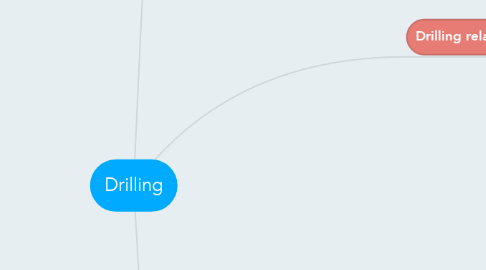
1. Drilling related to water
1.1. types/purpose
1.1.1. groundwater sampling/monitoring
1.1.2. wells for clean water
1.1.2.1. agriculture/aquaculture
1.1.2.2. recreation/gardening
1.1.3. remidiation
1.2. determining location
1.2.1. contaminant sources
1.2.1.1. industrial
1.2.1.2. residential
1.2.2. surface water
1.2.3. accessibility
1.2.4. topography
1.2.5. vegetation
1.2.6. subsurface conditions/soil types
1.3. common drilling methods
1.3.1. jet drilling
1.3.2. down the hole hammer
1.3.2.1. high repair/maintenance costs
1.3.2.2. fastest hard penetration
1.3.3. rotary drilling
1.3.3.1. handles most rocks
1.3.3.2. water/mud supply required
1.3.3.3. large/expensive
1.3.4. auger
1.3.4.1. cheap
1.3.4.2. no fluid contamination
1.3.5. cable tool
1.3.5.1. cheaper
1.3.5.2. difficult vs hard rock
1.3.5.3. slower
2. Oil and Gas
2.1. conventional
2.1.1. onshore
2.1.1.1. predicting blowouts?
2.1.1.2. subsidence due to HC extraction
2.1.1.3. contamination of gas from drilling mud
2.1.2. offshore
2.1.2.1. artificial islands/floating platforms
2.1.2.2. semi-submersibles
2.2. uncoventional
2.2.1. hydraulic fracturing
2.2.1.1. gw contamination
2.2.1.2. gw usage
2.2.1.3. micro seismicity
2.2.2. coal bed methane
2.2.2.1. How?
2.2.2.1.1. how is it different?
2.2.2.1.2. geotech implications
2.2.2.2. issues
2.2.2.2.1. enormous amounts of water used
2.2.2.2.2. surface water dicharge
2.2.3. steam enhanced recovery
2.2.3.1. How?
2.2.3.2. issues
2.2.3.2.1. lots of water used
2.2.3.2.2. possible source contamination
3. Drilling in hard rock
3.1. exploration
3.1.1. deep sea
3.1.2. arctic/antarctic
3.1.3. martian terrain
3.1.3.1. mineralogical exploration
3.1.3.2. terrestrial lacustrine deposits
3.2. prospecting and developing
3.2.1. the quest for resources
3.3. acquiring data for modelling
3.3.1. Antarctica's role in environment change
3.3.2. core samples from peak ring of Chicxulub
3.4. investigation
3.4.1. permafrost surveys
3.4.2. martian terrain
3.4.2.1. exobiological investigation
3.4.2.2. sub- oxidized surface investigation

